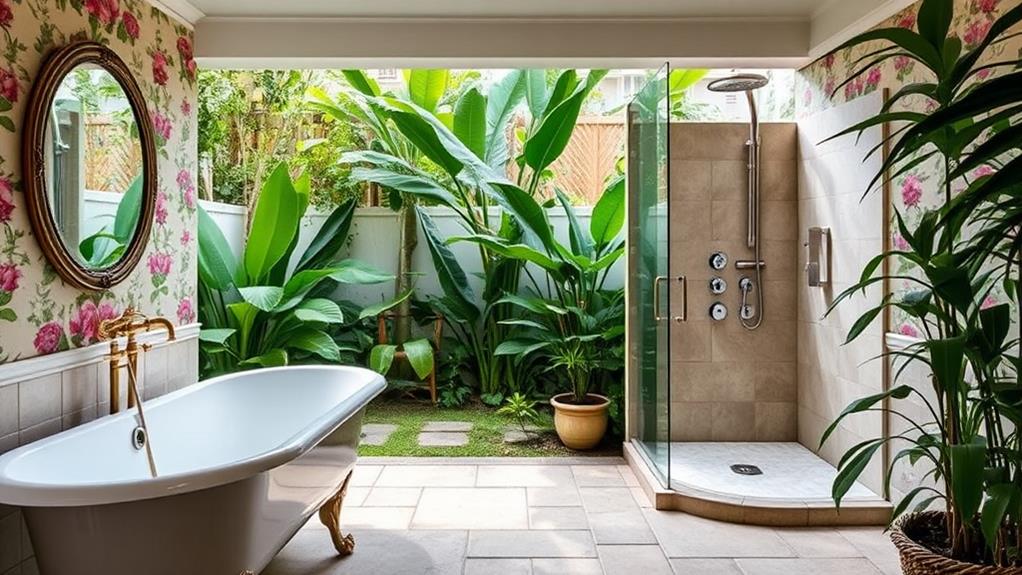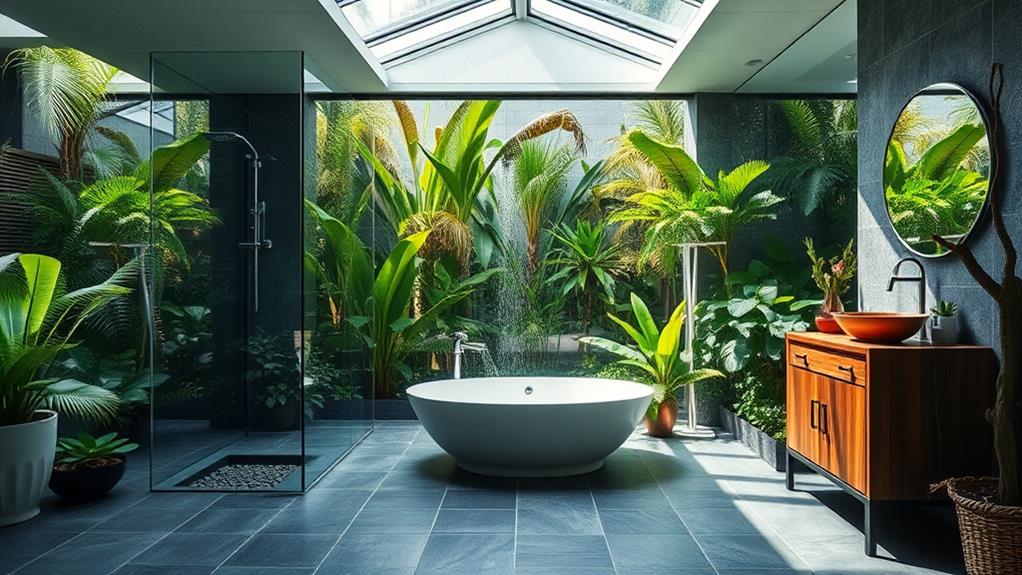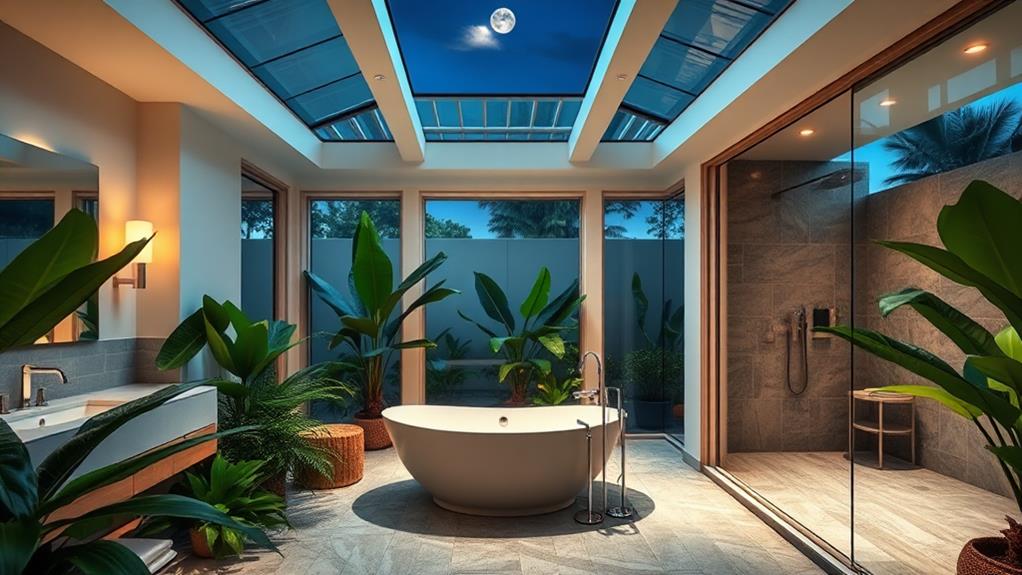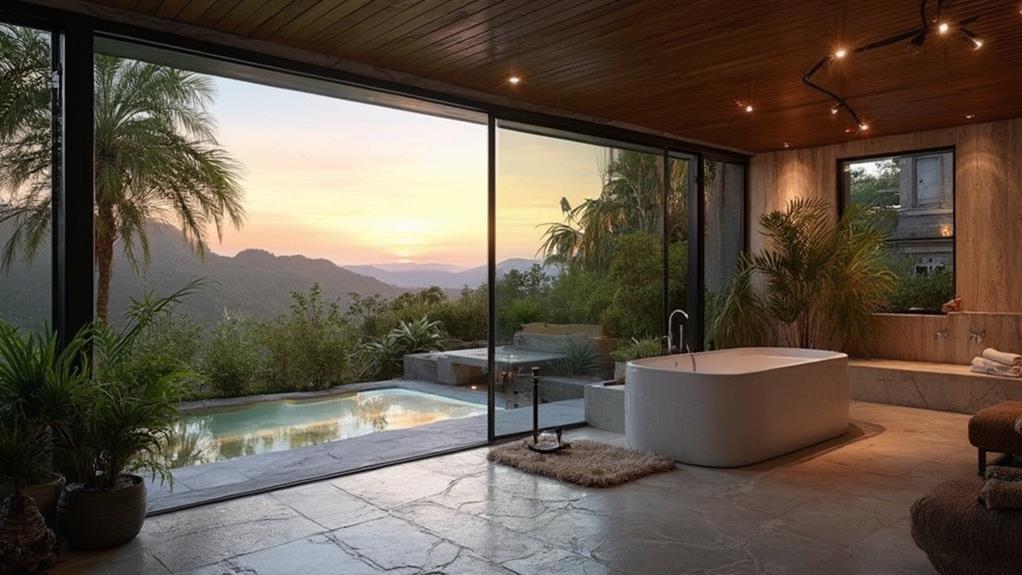Bathroom design has evolved from basic functionality to luxurious retreats that blend indoor comfort with outdoor ambiance. You can create a seamless indoor-outdoor experience by incorporating natural materials like stone and wood, maximizing natural light, and adding lush plants. Use weather-resistant materials for a smooth transition between spaces, and balance natural and artificial lighting for a cohesive atmosphere. Don't forget to consider sustainability with eco-friendly fixtures and water-saving features. By carefully selecting materials, lighting, and design elements, you'll transform your bathroom into a tranquil oasis that connects you with nature. The journey from ancient latrines to modern, nature-inspired sanctuaries is fascinating and inspiring.
Historical Perspective on Bathroom Design

Throughout history, bathrooms have evolved from simple outdoor latrines to sophisticated indoor spaces. You'll find that ancient civilizations like the Romans and Greeks pioneered public bathhouses, which served both hygienic and social purposes. These communal spaces laid the groundwork for future bathroom designs.
In medieval times, you'd have encountered chamber pots and outdoor privies as the norm. It wasn't until the 19th century that indoor plumbing became more widespread, revolutionizing bathroom design. You'd have seen the introduction of flushing toilets, running water, and dedicated bathroom spaces within homes.
The 20th century brought significant advancements. You'd have witnessed the rise of mass-produced fixtures, colorful bathroom suites, and the integration of electricity for lighting and appliances. Mid-century designs embraced modernism, featuring sleek lines and minimalist aesthetics.
Today, you're experiencing a bathroom renaissance. Design focuses on creating spa-like retreats with luxury features such as heated floors, smart toilets, and rainfall showerheads. The trend towards seamless indoor-outdoor bathrooms is the latest evolution, blurring the lines between nature and interior spaces while maintaining privacy and comfort.
Bringing Nature Indoors
Lush greenery and natural elements are key to bringing the outdoors into your bathroom. You'll want to incorporate plants that thrive in humid environments, such as ferns, orchids, and bamboo. Place them strategically on windowsills, countertops, or hanging planters to create a tropical oasis. Consider adding a living wall or vertical garden for a dramatic effect.
Natural materials like stone, wood, and pebbles can further enhance the outdoor feel. Install a pebble floor in your shower area or use river rocks as a decorative element around your bathtub. Opt for wooden vanities or shelving units to add warmth and texture.
Large windows or skylights will flood your bathroom with natural light, blurring the lines between indoors and outdoors. Water features, like a small fountain or a rainfall showerhead, can mimic the sounds of nature. Use organic, earthy colors in your bathroom's palette to complement the natural elements. Don't forget to incorporate natural scents through essential oils or candles to complete the sensory experience. By thoughtfully integrating these elements, you'll create a bathroom that feels like a serene retreat in nature.
Key Elements of Outdoor-Inspired Bathrooms

To create an outdoor-inspired bathroom, you'll need to focus on several key elements that bring nature's essence indoors. Start by incorporating natural materials like stone, wood, and bamboo in your fixtures and furnishings. These textures will add warmth and authenticity to your space.
Maximize natural light by installing large windows or skylights, allowing sunlight to flood the room. If privacy is a concern, use frosted glass or strategically placed plants to maintain seclusion. Add living plants to purify the air and create a lush, tropical ambiance.
Water features, such as a rainfall shower or a small fountain, can evoke the soothing sounds of nature. Choose earthy color palettes inspired by landscapes, like greens, browns, and blues. Install dimmer switches to mimic the changing light throughout the day.
Consider open-air elements like an outdoor shower or a bathtub on a private deck. Use weatherproof materials and proper drainage to ensure durability. Incorporate natural ventilation through windows or a fan to maintain fresh air circulation.
Materials for Seamless Transitions
When creating a seamless indoor-outdoor bathroom experience, choosing the right materials is crucial. You'll want to select options that can withstand both indoor and outdoor elements while maintaining a cohesive look. Consider using natural stone, such as slate or travertine, for flooring that extends from the interior to the exterior. These materials are durable, slip-resistant, and create a smooth transition between spaces.
For walls, opt for weather-resistant materials like treated wood, stone veneer, or porcelain tiles that mimic natural textures. These can be used both inside and outside, ensuring visual continuity. Glass is another excellent choice for seamless transitions, as it can be used for shower enclosures, windows, and even sliding doors that open to the outdoor area.
When it comes to fixtures and accessories, choose materials that can withstand moisture and temperature changes. Stainless steel, teak, and marine-grade fabrics are ideal for outdoor use and can be incorporated into your indoor bathroom design. By carefully selecting materials that work well in both environments, you'll create a harmonious flow between your indoor and outdoor bathroom spaces, blurring the lines between the two areas.
Lighting and Ambiance

Lighting plays a crucial role in creating a seamless indoor-outdoor bathroom experience. You'll want to balance natural and artificial light sources to maintain a cohesive ambiance throughout the day. Consider installing skylights or large windows to maximize natural light, blurring the boundaries between indoor and outdoor spaces.
For artificial lighting, opt for layered solutions that mimic natural light patterns. Use warm, dimmable LEDs to create a soft glow that complements the outdoor environment. Install adjustable spotlights to highlight key features and create depth. Incorporate waterproof fixtures in shower areas and near water features to ensure safety and durability.
Don't forget about outdoor lighting. Illuminate pathways and landscaping elements to extend the bathroom's visual space into the exterior. Use subtle uplighting on plants or architectural features to create a magical nighttime atmosphere.
To enhance the ambiance, incorporate natural elements like potted plants or living walls. These additions will soften the transition between indoor and outdoor spaces while purifying the air. Finally, consider adding a sound system that can play nature sounds or soft music, further blurring the lines between inside and outside.
Sustainability in Indoor-Outdoor Bathrooms
Sustainability is a key consideration when designing an indoor-outdoor bathroom. You'll want to incorporate eco-friendly materials and energy-efficient systems to minimize your environmental impact. Choose sustainable materials like bamboo, reclaimed wood, or recycled glass for surfaces and fixtures. Install low-flow toilets, faucets, and showerheads to conserve water without sacrificing performance.
Harness natural light and ventilation to reduce energy consumption. Skylights and strategically placed windows can illuminate your space during the day, while solar-powered lights can provide ambiance at night. Consider installing a rainwater harvesting system to collect and reuse water for flushing toilets or watering plants.
Opt for native, drought-resistant plants in your outdoor shower area to reduce water usage and maintenance. Implement a greywater system to recycle water from sinks and showers for irrigation. Use natural cleaning products to prevent harmful chemicals from entering the environment.
Invest in energy-efficient appliances and HVAC systems to minimize your carbon footprint. Consider installing solar panels to power your bathroom's electrical needs. By prioritizing sustainability, you'll create an eco-friendly oasis that seamlessly blends indoor comfort with outdoor beauty.
Conclusion
You might worry about privacy in an indoor-outdoor bathroom, but clever design can address this concern. By embracing nature-inspired elements, you'll transform your bathroom into a luxurious retreat. You're not just creating a functional space; you're crafting an experience. With sustainable materials, strategic lighting, and seamless transitions, you'll blur the lines between indoors and out. It's time to reimagine your bathroom as a sanctuary that connects you with nature while providing ultimate comfort and style.

